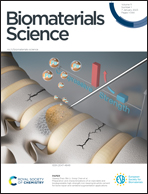Inhibition and eradication of bacterial biofilm using polymeric materials
Abstract
Biofilms, ubiquitous in nature, are three-dimensional complex microbial communities sheathed in a self-secreted extracellular polymeric matrix. Infections caused by these communities have sprouted as serious threats to global healthcare systems due to their intrinsic tolerance toward conventional antibiotics. There is a huge demand for alternative “cutting-edge” materials featuring strong antibiofilm abilities to mitigate and/or exterminate pre-matured biofilms. Natural or synthetic macromolecule-based compounds have evolved as one of the most sought-after materials because of their unique stimulus-directed selective targeting efficiency to the bacterial cell, antibiotic-encapsulation ability endowing them with a synergistic effect, and highly dense embedded cationic functionalities that promote accumulation within the biofilm. In this comprehensive review, we aim to highlight the progress made in inhibiting or eradicating bacterial biofilms using various forms of polymeric material including cationic and charge-switchable macromolecules, conjugated polymers, polymeric metal nanocomposites, hydrogels, and supramolecular polymers. We particularly emphasize understanding the underlying antibiofilm mechanisms of each presented example ushered in by state-of-the-art synthetic strategies. Lastly, focusing on bench-to-bedside, the review is concluded by providing some forthcoming aspects and possible future development directions to expand polymer-based antibiofilm research, keeping their clinical translations in mind.



 Please wait while we load your content...
Please wait while we load your content...